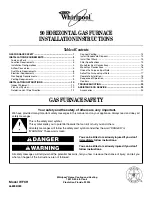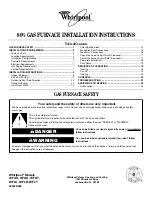
Caf Digital Imaging
MF36
page 5
To minimise the risks associated with CO it is most important that the furnace is installed and
operated in accordance with this instruction manual. If the furnace operator experiences any of
the effects listed above, the furnace must be isolated from the gas and electricity supplies
immediately and expert advice sought. For safety guidelines seek the gas manufacturers advice.
Table 1. Carbon monoxide in air:
Information extracted from Guidance Note EH43 (1996) from the Health and Safety Executive.
Parts per
million
Effect.
50
Recommended Exposure Limit (8 hours time weighted average concentration).
200
Headache after about 7 hours if resting or after 2 hours exertion.
400
Headache with discomfort with possibility of collapse after 2 hours at rest or 45
minutes exertion.
1200
Palpitations after 30 minutes at rest or 10 minutes exertion.
2000
Unconscious after 30 minutes at rest or up to 10 minutes exertion.
For further information refer to:
- Guidance Note EH43 (1996) from the Health and Safety Executive. ISBN 0 11 883597 1
- EH40/97 Occupational Exposure Limits 1997. ISBN 0 7176 1315 1
1.3
Hydrogen and Carbon Dioxide Warning.
Applicable for furnaces constructed to use H
2
and CO
2
test gases with CO
2
‘Purge’ gas.
H
2
can form explosive gas mixtures, take precautions to avoid leakage of
H
2
. H
2
and CO
2
can react to form CO. See section 1.2: Carbon Monoxide
Warning.
Carbon dioxide (CO
2
) is a colourless, odourless and tasteless gas that is an
asphyxiant. Rapid unconsciousness occurs at levels above 11%, levels of 20 - 30% are
immediately hazardous to life.
Information extracted from Croner Publications Ltd. Substances Hazardous To Health.
To minimise the risks associated with CO
2
it is most important that the furnace is installed and
operated in accordance with this instruction manual. If the furnace operator experiences any of
the effects listed above, the furnace must be isolated from the gas and electricity supplies
immediately and expert advice sought. For safety guidelines seek the gas
manufacturers advice.
1.4
Refractory Fibrous Insulation Warning.
This furnace contains refractory fibres in its thermal insulation. These
materials may be in the form of fibre blanket or felt, vacuum formed board
or shapes, mineral wool slab or loose fill fibre.
Normal use of the furnace does not result in any significant level of
airborne dust from these materials, but much higher levels may be
encountered during maintenance or repair.
Whilst there is no evidence of any long term health hazards, we strongly recommend that safety
precautions are taken whenever the materials are handled:
Exposure to dust from fibre that has been used at high temperatures may cause respiratory
disease.
When handling fibre always use an approved mask, eye protection, gloves and long sleeved
clothing.
Avoid breaking up waste material. Dispose of waste fibre in sealed containers.
After handling rinse exposed skin with water before washing gently with soap (not detergent).
Wash work clothing separately.






































